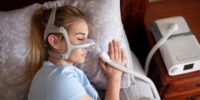What Is The Connection Between Sleep Apnea And Diabetes?

Sleep apnea and diabetes are two prevalent health conditions that affect millions of people worldwide. Sleep apnea is a sleep disorder characterized by pauses in breathing or shallow breaths during sleep, often accompanied by loud snoring or gasping for air. On the other hand, diabetes is a chronic metabolic disorder that affects the body’s ability to regulate blood sugar levels.
While these two conditions may seem unrelated, research has shown a clear connection between them. People with sleep apnea are at a higher risk of developing type 2 diabetes, and individuals with diabetes are more likely to have sleep apnea. Both conditions share common risk factors and symptoms, such as obesity and hypertension. Furthermore, the presence of one condition can worsen the other, leading to more severe health complications.
Understanding the link between sleep apnea and diabetes is crucial for effective diagnosis, treatment, and overall management of these conditions. This article explores the connection between sleep apnea and diabetes, including shared symptoms, challenges, diagnosis, treatment options, lifestyle changes, and collaborative care approaches.
Key Takeaways
- Sleep apnea and diabetes are interconnected health conditions.
- Both sleep apnea and diabetes increase the risk of developing the other.
- Obesity and hypertension are common risk factors for both conditions.
- Treatment options for sleep apnea, such as CPAP therapy, can improve glycemic control in diabetes.
Understanding Sleep Apnea
Sleep apnea is a potentially serious sleep disorder characterized by pauses in breathing or shallow breaths during sleep. It is estimated that around 22 million Americans suffer from some form of sleep apnea. The condition is often undiagnosed, as its symptoms are commonly attributed to other factors.
Sleep apnea is classified into three types:
- Obstructive sleep apnea, which is the most common form and occurs when the muscles in the throat fail to keep the airway open.
- Central sleep apnea, which is caused by the brain’s failure to transmit proper signals to the muscles that control breathing.
- Complex sleep apnea syndrome, which is a combination of obstructive and central sleep apnea.
It is important to diagnose and treat sleep apnea as it is associated with several health complications, including diabetes.
The Link Between Sleep Apnea and Diabetes
The association between obstructive sleep-disordered breathing and the metabolic dysfunction frequently observed in individuals with type 2 diabetes has been extensively studied.
Sleep apnea, a common sleep disorder characterized by repeated pauses in breathing during sleep, has been found to be significantly associated with an increased risk of developing type 2 diabetes.
The mechanisms underlying this link are complex and multifactorial. Sleep apnea can lead to intermittent hypoxia and sleep fragmentation, which can disrupt glucose metabolism and insulin sensitivity.
Additionally, the chronic inflammation and oxidative stress associated with sleep apnea can further contribute to the development of insulin resistance and impaired glucose tolerance.
Furthermore, the excessive daytime sleepiness and fatigue often experienced by individuals with sleep apnea may lead to sedentary behavior and poor dietary choices, further compounding the risk of developing diabetes.
Understanding and addressing the connection between sleep apnea and diabetes is crucial for the management and prevention of these conditions.
This discussion will focus on the shared symptoms and challenges between sleep apnea and diabetes, namely fatigue and daytime sleepiness, impaired glucose regulation, and cardiovascular risks.
Fatigue and daytime sleepiness are common symptoms experienced by individuals with both sleep apnea and diabetes, which can significantly impact their daily functioning and quality of life.
Additionally, both conditions are associated with impaired glucose regulation, leading to difficulties in maintaining stable blood sugar levels.
Lastly, individuals with sleep apnea and diabetes face an increased risk of cardiovascular complications, highlighting the importance of early detection and intervention for these coexisting conditions.
Fatigue and Daytime Sleepiness
Fatigue and daytime sleepiness are common symptoms experienced by individuals with sleep apnea, contributing to decreased productivity and impaired cognitive function. Sleep apnea disrupts the normal sleep patterns, causing frequent awakenings throughout the night. As a result, individuals with sleep apnea often wake up feeling tired and struggle to stay awake during the day. This excessive daytime sleepiness can have significant consequences, including increased risk of accidents and decreased quality of life.
To illustrate the impact of fatigue and daytime sleepiness, a table is provided below that compares the typical sleep needs of adults with the amount of sleep obtained by individuals with sleep apnea.
| Sleep Needs (hours) | Average Sleep Duration in Individuals with Sleep Apnea |
|---|---|
| 7-9 | 4-6 |
| ——————— | ——————————————————- |
It is clear from the table that individuals with sleep apnea are not obtaining the recommended amount of sleep, which can further exacerbate their fatigue and daytime sleepiness. Effective management of sleep apnea is crucial in alleviating these symptoms and improving overall well-being.
Impaired Glucose Regulation
Impaired glucose regulation is a common concern associated with sleep apnea, highlighting the importance of managing this sleep disorder for overall health and well-being.
Research has shown that individuals with sleep apnea often exhibit abnormalities in glucose metabolism, leading to impaired glucose regulation. This can result in increased blood sugar levels and a higher risk of developing type 2 diabetes.
To further emphasize the impact of impaired glucose regulation in sleep apnea, consider the following sub-lists:
- Sleep apnea can contribute to insulin resistance, a condition where the body’s cells become less responsive to the effects of insulin, leading to elevated blood sugar levels.
- The intermittent oxygen deprivation experienced during sleep apnea episodes can trigger a stress response in the body, leading to increased production of cortisol, a hormone that can interfere with glucose regulation.
Overall, addressing sleep apnea is crucial in managing impaired glucose regulation and reducing the risk of developing diabetes.
Cardiovascular Risks
Impaired glucose regulation is not the only connection between sleep apnea and diabetes; cardiovascular risks also play a significant role. Research indicates that individuals with sleep apnea have a higher risk of developing cardiovascular diseases, such as hypertension, coronary artery disease, and stroke, which are also common comorbidities in diabetes. The underlying mechanism behind this association involves a combination of factors, including intermittent hypoxia, sympathetic activation, oxidative stress, and inflammation. These factors contribute to the development and progression of atherosclerosis and endothelial dysfunction, leading to an increased risk of cardiovascular events. It is crucial to address sleep apnea in individuals with diabetes to mitigate these cardiovascular risks and improve overall health outcomes.
| Cardiovascular Risks |
|---|
| Hypertension |
| Coronary artery disease |
| Stroke |
Diagnosis and Treatment Options
One method for diagnosing sleep apnea involves conducting a sleep study, during which a patient’s breathing patterns, heart rate, and oxygen levels are monitored overnight in a controlled environment. This study, known as polysomnography, helps to determine the severity of sleep apnea and identify the specific type of the condition.
Once diagnosed, there are several treatment options available for individuals with sleep apnea. These include:
- Continuous positive airway pressure (CPAP) therapy: This treatment involves wearing a mask over the nose or mouth during sleep, which delivers a continuous flow of air to keep the airways open.
- Oral appliances: These devices are custom-made and worn during sleep to reposition the jaw and tongue, helping to maintain an open airway.
- Lifestyle changes: Certain lifestyle modifications such as losing weight, avoiding alcohol and sedatives, and sleeping on the side can help improve symptoms of sleep apnea.
- Surgical interventions: In severe cases, surgical procedures may be recommended to remove excess tissue or correct structural abnormalities that contribute to sleep apnea.
Lifestyle Changes for Better Health
This discussion will focus on the importance of weight management, regular exercise, and healthy sleep habits for better health.
Weight management plays a crucial role in overall health as it can have a significant impact on various conditions, including sleep apnea and diabetes.
Regular exercise is essential for maintaining a healthy weight, improving cardiovascular health, and reducing the risk of developing chronic diseases.
Additionally, healthy sleep habits, such as maintaining a consistent sleep schedule and creating a comfortable sleep environment, can promote better sleep quality and overall well-being.
Weight Management
Weight management is an essential aspect to consider when exploring the relationship between sleep apnea and diabetes. Obesity and excess body weight are significant risk factors for both conditions. Excessive weight can lead to the narrowing of the upper airway, increasing the likelihood of sleep apnea. Additionally, obesity is associated with insulin resistance, a key factor in the development of type 2 diabetes.
Weight loss interventions, such as diet modifications, increased physical activity, and behavioral changes, have been shown to improve both sleep apnea and diabetes outcomes. These interventions aim to reduce body weight, improve insulin sensitivity, and alleviate the severity of sleep apnea.
Successful weight management can lead to a reduction in the risk and severity of both sleep apnea and diabetes, highlighting the importance of addressing weight-related factors in the management of these conditions.
Regular Exercise
Regular exercise is an essential component of weight management and it can also play a crucial role in the management of sleep apnea and diabetes. Engaging in regular physical activity has been shown to improve sleep quality and reduce the severity of sleep apnea symptoms. Exercise helps in weight loss, which can alleviate the symptoms of sleep apnea and improve insulin sensitivity in individuals with diabetes.
Furthermore, regular exercise has been found to lower the risk of developing type 2 diabetes and its related complications. It improves glucose control, enhances insulin action, and promotes weight loss. Incorporating aerobic exercises, resistance training, and flexibility exercises into one’s routine can have significant benefits for individuals with sleep apnea and diabetes.
- Aerobic exercises
- Resistance training
- Flexibility exercises
Healthy Sleep Habits
Healthy sleep habits are crucial for maintaining overall well-being and optimizing various physiological functions. Adequate and restful sleep is essential for the body to repair and rejuvenate itself. It allows for the consolidation of memories, enhances cognitive function, and regulates mood. Moreover, healthy sleep habits have been linked to a reduced risk of developing chronic conditions such as diabetes, cardiovascular disease, and obesity.
To emphasize the importance of healthy sleep habits, the following table presents a comparison between individuals who practice good sleep habits and those who do not:
| Good Sleep Habits | Poor Sleep Habits |
|---|---|
| Wake up refreshed | Wake up tired |
| Increased productivity | Decreased productivity |
| Improved concentration | Difficulty concentrating |
| Enhanced immune system | Weakened immune system |
| Lower risk of chronic diseases | Higher risk of chronic diseases |
This comparison clearly demonstrates the positive impact that healthy sleep habits can have on overall well-being and highlights the potential consequences of poor sleep habits.
Collaborative Care and Support
This paragraph discusses the importance of early detection and intervention, research and advancements in treatment, and promoting awareness and education in the collaborative care and support for individuals with sleep apnea and diabetes.
Early detection and intervention are crucial in managing both conditions and preventing further complications.
Research and advancements in treatment play a significant role in improving the outcomes for individuals with sleep apnea and diabetes.
Promoting awareness and education is essential in increasing understanding and knowledge about these conditions, which can lead to better management and support.
Importance of Early Detection and Intervention
Early detection and intervention of sleep apnea in individuals with diabetes is of utmost significance. Sleep apnea is a common disorder characterized by interrupted breathing during sleep. Research suggests a bidirectional relationship between sleep apnea and diabetes, with one condition exacerbating the other. Detecting sleep apnea early in individuals with diabetes is crucial because it can lead to several adverse health outcomes if left untreated.
The following nested bullet point list highlights the importance of early detection and intervention in evoking emotion in the audience:
- Improved quality of life: Early intervention can alleviate symptoms of sleep apnea, such as excessive daytime sleepiness and fatigue, improving overall quality of life for individuals with diabetes.
- Reduced risk of complications: Identifying and managing sleep apnea early can help decrease the risk of complications associated with diabetes, such as cardiovascular disease and insulin resistance.
- Improved glycemic control: Treating sleep apnea can lead to better control of blood sugar levels in individuals with diabetes, reducing the risk of hyperglycemia and improving overall diabetes management.
Research and Advancements in Treatment
Promising advancements in the field of medical research have led to improved treatment options for individuals with both sleep apnea and diabetes. Researchers have recognized the complex relationship between these two conditions and are actively working towards finding effective interventions.
One significant area of advancement is the development of continuous positive airway pressure (CPAP) therapy. CPAP machines deliver a constant flow of air pressure, keeping the airways open and reducing the risk of apnea episodes during sleep. Studies have shown that CPAP therapy not only improves sleep quality but also helps regulate blood glucose levels in individuals with both sleep apnea and diabetes.
Other emerging treatment options include oral appliances and upper airway stimulation therapy.
With ongoing research and advancements, individuals with sleep apnea and diabetes can now access a wider range of treatment options to manage their conditions effectively.
Promoting Awareness and Education
Awareness and education play a crucial role in equipping individuals with the knowledge and understanding necessary to effectively manage and mitigate the impact of these interconnected health conditions.
Promoting awareness about the connection between sleep apnea and diabetes is essential to ensure that individuals with either condition are properly informed and seek appropriate medical attention.
Education initiatives can help individuals understand the potential risk factors and symptoms associated with both conditions, as well as the importance of early diagnosis and treatment.
Additionally, raising awareness among healthcare professionals can lead to improved screening and diagnosis rates, ensuring that individuals receive timely and appropriate care.
By providing accurate and accessible information, promoting awareness and education can empower individuals to make informed decisions regarding their health, leading to better management and outcomes for both sleep apnea and diabetes.
Frequently Asked Questions
What are the long-term consequences of untreated sleep apnea for individuals with diabetes?
Untreated sleep apnea in individuals with diabetes can have long-term consequences. It may worsen insulin resistance, leading to poorer glycemic control and increased risk of cardiovascular complications. Treatment of sleep apnea is crucial in managing diabetes effectively.
Can sleep apnea be a risk factor for developing diabetes?
Sleep apnea can be a risk factor for developing diabetes. Research suggests that the intermittent hypoxia and sleep fragmentation associated with sleep apnea may contribute to insulin resistance and impaired glucose metabolism, increasing the likelihood of developing diabetes.
Are there any alternative treatment options for sleep apnea besides continuous positive airway pressure (CPAP) therapy?
Alternative treatment options for sleep apnea include oral appliances, positional therapy, lifestyle changes, and surgery. These options may be considered in cases where continuous positive airway pressure (CPAP) therapy is not well-tolerated or ineffective.
How does sleep apnea affect insulin resistance in individuals with diabetes?
Sleep apnea affects insulin resistance in individuals with diabetes by causing intermittent hypoxia and sleep fragmentation. These factors lead to increased sympathetic activity, inflammation, oxidative stress, and impaired glucose metabolism, ultimately exacerbating insulin resistance and worsening glycemic control in diabetic patients.
Is it possible to reverse the effects of sleep apnea on diabetes by effectively treating the sleep disorder?
It is possible to reverse the effects of sleep apnea on diabetes by effectively treating the sleep disorder. Treating sleep apnea can improve insulin resistance and glycemic control, reducing the risk of complications and improving overall health in individuals with diabetes.










